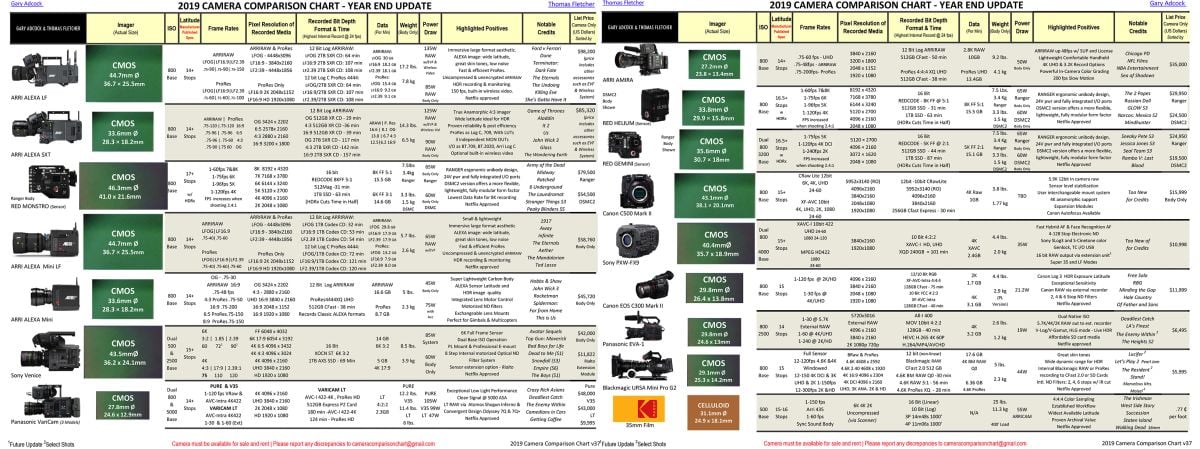
2019 Camera Comparison Chart - UPDATED
The latest edition of this informative tool, created by ASC associate member Tom Fletcher and Gary Adcock, has arrived.
The latest edition of this informative tool, created by ASC associate member Tom Fletcher and Gary Adcock, has arrived.
UPDATED 12-31-2019: The chart now includes added/updated entries on three large-format cameras:
Canon C500 Mark II (Now available for sale and rent)
Sony PXW-FX9 (Now available for sale and rent)
Sony Venice Frame Rates (New firmware with higher frame rates)
Click here to view the 2019 Chart
This Camera Comparison Chart is the latest in an annual series published by Fletcher since 2007, each featuring Adcock’s assistance as technical advisor and additional input from various cinematographers (including ASC members Robert Primes, David Stump, Bill Bennett and ASC President Kees van Oostrum), colorists, rental houses and camera manufacturers.
In 2017, Adcock took over the reins as the main contact and producer when Fletcher assumed duties with an unaffiliated manufacturer.
“From the beginning, the chart has been designed around providing a tool for cinematographers to help them educate producers with the incredibly large variety of tools available to them,” explains Adcock. “We have kept the Camera Comparison Chart focused on mainstream production cameras that are available for rental or purchase around the world to maintain that relevance, but that is also the reason that cameras such as Arri’s Alexa 65 and Panavision’s DXL cameras are not included here, even though those cameras are widely utilized in both television and feature films.”

A great deal of thought goes into determining both what is put on — and taken off — the list. According to Fletcher, this process is driven by popularity and sales of new cameras. “[Cameras that have been removed] are still excellent tools in the market, but they are no longer very active in the new sales market.”
“Many of the relevant cameras have changed over the years,” says Adcock, “Take a camera like Vision Research’s 4K Flex, which has not radically changed in a couple of years, is not any less camera when it shipped, is no longer on the current chart, but is still as viable as it was when it was first released. There is only so much room, the cameras come and go, most notably the C300MK2 has been on the chart longer than any other camera, even though Tom and I are working under the assumption that it will be replaced by the C500MK2 when it ships early next year.
“Being relevant to the rental industry is key, Tom’s former company, Fletcher Camera and Lens, was one of the primary rental houses at the helped educate people at the start of the HD and digital revolution. Rental houses have always been a focal point in the film and television communities. They were important because production cameras where out of the price range most users could comfortably afford, so rental houses allowed a wider array of users access to cinematic production tools than could not have been achieved any other way.”

Every edition of the Camera Comparison Chart has been just two pages, a very intentional decision on Fletcher and Adcock’s part. “One of the main reasons we limit the chart to two pages is simply the time involved [in prepping the chart],” says Adcock. “Second is that many schools and rental houses print the chart out to hang in their prep areas. To further expand the offerings, we have started to look for a sponsorship that would allow us to expand the chart to cover DSLRs or the market for cameras available to to purchase under $10,000. There have also discussions about doing a lens chart, but that would be a huge undertaking without additional support.”
This years chart featured a number of cameras with large sensors. “Sensors are getting larger, and I expect them to continue growing,” Adcock says, “but that does not circumvent the thousands of S35 imagers on the market. Without the physical limitations of analog film, larger sensors and the corresponding data requirements will prevail. It was those limitations of size and weight that allowed 16mm and S35 formats to maintain such an extended lifespan. In the digital world we live in now, often the optics weigh far more than the rest of the camera package combined. As someone that grew up with 4x5 and 8x10 still cameras, having a cine camera that records on a 6cm sensor reminds me of my old Rolleifex and Hasselblad cameras of my youth.
“The other trend I see is that some manufacturers are once again making smaller 2/3" sensors for broadcast solutions that need that extended depth of field and lensing capabilities those smaller sensors allow in the news and sports markets.”
The larger sensors also meant that it would be physically difficult to fit as many entries on the chart's two pages. After much back and forth, the decision was made to continue to use the actual sensor sizes instead of scaling them down. “Tom and I have always thought the sensor sizing info is incredibly important,” Adcock points out. "When we started there were still 2/3" sensors that used B4 mounts on the VariCams and HDCams. Now everything is mostly PL or Canon EF mount, with Arri’s new LPL mount taking hold to bypass limitations as we zoom pass full-frame 35mm sensors. We maintain the imagery to visually refresh peoples thought process.
“I use that info when I have speaking session to point out that Sony’s Venice is the only ‘true’ VistaVision-sized sensor, based on the Academy’s published specs. Yet because Red’s Monstro and Arri’s LF sensors are larger than that does not take away from their capabilities anymore than choosing between 3-perf or 4-perf 35mm film stocks.”

A great deal of care goes into assembling the chart, including each camera’s credits. “When we started there was not much info published on what cameras were used on most projects,” remembers Adcock, “because everyone was shooting film, where the cameras were sometimes secondary to the film stocks that were used. The advent of digital production made everyone far more aware of the differences between each camera and the manufacturer’s products. Showing each cameras credits list allow us to better understand our own needs, requirements and look we are trying to achieve for our own productions. We all have gone to a movie or watched a TV show and wondered what it was shot with. Having the manufacturers allow us to credit their productions helps those productions and the DPs who shoot them, while supporting the manufacturers marketing efforts too. The best example of this on the 2019 chart is Canon’s C300MK2, as every single film listed was nominated for the Academy Award in documentary filmmaking."
When describing his and Fletcher’s roles in assembling the chart, Adcock says “We try to act as gatekeepers, but really it’s all about herding cats to confirm that we have all the correct information. We try to accommodate requests, but the single largest factor in our decision process is defined by the space limitations. We only have X characters available per line for each of the descriptions. This year, I had to whittle one large marketing paragraph down to the 28 characters available, so part of our job is having enough insight on what users are truly looking for from the data. That has always been the most important factor to both of us.”
To learn more about the chart and how it is made check out our article on last year's chart.
Previous editions of the Camera Comparison Chart:
Adcock and Fletcher would like to thank those who offered assistance and feedback in the collection of the data:
Geoff Boyle, NSC, cinematographer
Scott Dale, VER/PRG
Megan Donnelly, AbelCine Burbank
Stosh Durbacz, Fujifilm
Phil Holland, cinematographer
Michael Koerner, Koerner Camera
Jim Mathers, cinematographer/Digital Cinema Society
Mike Sippel, Arri Rental
David Stump, ASC, cinematographer
Marcelo Trotta, ABC, cinematographer
Bruno Vieira, cinematographer
ARRI
Marc Shipman-Mueller
Frederick Merten
Marina Aytpakov
BLACKMAGIC DESIGN
Tor Johansen
Tim Schumann
CANON
Larry Thorpe
Tim Smith
Michael Bravin
RED
Kenta Honjo
Alan Zarnegar
Loren Simons
Naida Albright
PANASONIC
Barry Russo
Mitch Gross
SONY
Simon Marsh
KODAK
Mike Brown
Bob Mastronardi
Anne Hubbell






